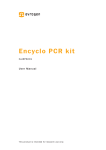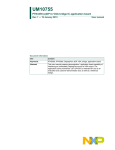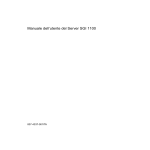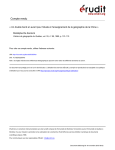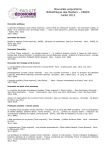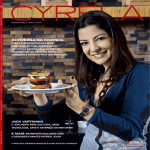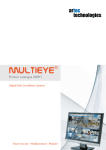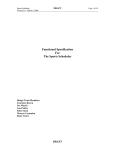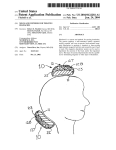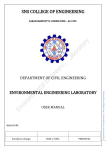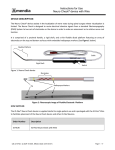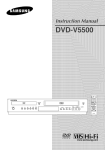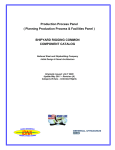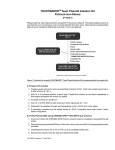Download Diversify® PCR Random Mutagenesis Kit User Manual
Transcript
User Manual Diversify® PCR Random Mutagenesis Kit User Manual United States/Canada 800.662.2566 Asia Pacific +1.650.919.7300 Europe +33.(0)1.3904.6880 Japan +81.(0)77.543.6116 Clontech Laboratories, Inc. A Takara Bio Company 1290 Terra Bella Ave. Mountain View, CA 94043 Technical Support (US) E-mail: [email protected] www.clontech.com Cat. No. 630703 PT3393-1 (PR812469) Published 23 January 2008 Diversify® PCR Random Mutagenesis Kit User Manual Table of Contents I. Introduction 4 II. List of Components 6 III. Additional Materials Required 7 IV. General Considerations 8 A. Template and Primer Design 8 B. Choosing Buffer Conditions 8 C. Mutational Bias 9 D. Control Reaction 10 V. Random Mutagenesis Procedure 11 A. Setting Up and Running Reactions 11 B. Taq I PCR Fidelity Assay 12 VI. Troubleshooting 13 VII. References 16 VIII. Related Products 17 Appendix : Mutational Data from DNA Sequencing 18 Clontech Laboratories, Inc. www.clontech.com 2 Protocol No. PT3393-1 Version No. PR812469 Diversify® PCR Random Mutagenesis Kit User Manual List of Figures Figure 1. The level of Diversify mutagenesis is controlled by varying the concentrations of manganese and dGTP 5 Figure 2. Taq I PCR Fidelity Assay 10 Figure 3. Distribution of mutations per clone for different Diversify buffer conditions 18 List of Tables Table I. Mutagenesis PCR reaction buffer conditions 9 Table II. Mutational bias for Diversify mutagenesis 9 Table III. Mutagenesis reactions 11 Table IV. Diversify mutagenesis sequencing data 18 Protocol No. PT3393-1 www.clontech.com Version No. PR812469 Clontech Laboratories, Inc. 3 Diversify® PCR Random Mutagenesis Kit User Manual I. Introduction PCR-based random mutagenesis is widely used for analyzing wild-type protein function and creating proteins with new or improved functions (e.g., directed protein evolution). The procedure generally involves performing a PCR reaction under conditions that reduce the fidelity of nucleotide incorporation, cloning the resulting PCR fragments, and then screening the resulting library for novel mutations which affect protein activity (You et al., 1994; Wan et al., 1998; Melnikov et al., 1999). PCR-based random mutagenesis has gained popularity over chemical methods (e.g., nitrous acid, hydroxylamine, etc.) since it produces higher levels and a larger variety of mutations (Fromant et al., 1995). Additionally, PCR-based random mutagenesis has advantages over the use of nucleotide analogs because analogs have an increased bias for certain point substitutions and must be removed from PCR products prior to cloning. The Diversify PCR Random Mutagenesis Kit offers a variety of buffer conditions for performing random mutagenesis, allowing you to adjust the reaction for a desired error rate. The kit is based on the methods of Leung et al. (1989) and Cadwell and Joyce (1992) and has been optimized for use with the Clontech TITANIUMTaq PCR system. The primary advantages of the kit are: • Controlled random mutagenesis: the buffer conditions can be varied to achieve the desired levelof random mutagenesis. • Amplification of large PCR fragments: we have confirmed amplification of fragments up to 4 kb in length. Theoretically, longer fragments can be mutated and amplified as well. • High DNA yields using the TITANIUM Taq PCR system, which outperforms other PCR systems under the stress of error-prone PCR conditions. TITANIUM Taq includesTaqStart Antibody for automatic hot-start PCR. • Wide mutational diversity: produce transition and transversion mutations. • A rapid in vitro control reaction (patent pending) that allows you to confirm randommutagenesisofacontroltemplatejust2hrsafteryourPCRreaction. Diversify PCR mutagenesis provides control over the level of random mutation by independently varying the amounts of manganese and dGTP in the PCR reaction (Figure 1). The mutagenesis rate is first raised by increasing the amount of manganese in the reaction (up to 640 µM). Further increases in mutation rate are obtained by increasing the level of dGTP in the reaction, while keeping the concentration of manganese constant. The kit has been designed to provide mutation rates from 2 to 8 mutations per 1,000 bp, making it applicable to large and small PCR products. Higher mutation rates can be produced by performing a second round of PCR using a diluted aliquot of the primary mutagenesis reaction (Shafikhani et al., 1997). Clontech Laboratories, Inc. www.clontech.com 4 Protocol No. PT3393-1 Version No. PR812469 Diversify® PCR Random Mutagenesis Kit User Manual I. Introduction continued Three of the mutation rates shown in Figure 1 (buffer conditions 1, 5, and 9) were determined directly by DNA sequencing (see Appendix). The remaining, intermediate points were determined by correlating mutagenesis levels from a reproducible, quantitative in vivo fidelity assay (Mo et al., 1991) with results from DNA sequencing. 700 # Mutations 8.0 600 Mn2+ 500 dGTP 6.0 400 300 4.0 200 2.0 Mn2+ or dGTP (M) Mutations per 1,000 bp 10.0 100 0.0 0 1 2 3 4 5 6 7 8 9 Buffer Condition Figure 1. The level of Diversify® mutagenesis is controlled by varying the concentrations of manganese and dGTP. The concentrations of other dNTPs are held constant. Protocol No. PT3393-1 www.clontech.com Version No. PR812469 Clontech Laboratories, Inc. 5 Diversify® PCR Random Mutagenesis Kit User Manual II. List of Components Store all components at –20°C. The following reagents are sufficient for 30 mutagenesis reactions of 50 µl each. • 30 µl 50X TITANIUM™ Taq DNA Polymerase (includes TaqStart Antibody) Concentration in 50X mix Component 50 % 20 mM 100 mM 0.1 mM 0.25 % 0.25 % Glycerol Tris-HCl (pH 8.0) KCl EDTA (pH 8.0) Tween-20 Nonidet P-40 Final rxn concentration 1.0 0.4 2 2.0 0.005 0.005 % mM mM µM % % • 200 µl 10X TITANIUM™ Taq PCR Buffer Concentration Final rxn in 10X mix Component concentration 400 mM Tricine-KOH (pH 8.0 at 25°C)40 mM 160 mM KCl16 mM 35 mM MgCl2 3.5 mM 37.5 µg/ml BSA 3.75 µg/ml • • 50X Diversify® dNTP Mix 50X dNTP Mix (standard dNTP mix; 10 mM each of dATP, dCTP, dGTP, and dTTP) dGTP (2 mM; final concentration variable from 40 to 200 µM) Manganese Sulfate (MnSO4; 8 mM; final concentration variable from 0 to 640 µM) Control PCR Template (~1ng/µl) Control Primer Mix (10 µM each) 30 µl 40 µl • 150 µl • 120 µl • • 10 µl 10 µl Forward Primer: 5'–GAGCCTATGGAAAAACGCCAGCAAC–3' Reverse Primer: 5'–GCAAAAAAGGGAATAAGGGCGACAC-3' • 10 µl Taq I Restriction Enzyme (20 units/µl) • 1.25 ml PCR Grade Water Clontech Laboratories, Inc. www.clontech.com 6 Protocol No. PT3393-1 Version No. PR812469 Diversify® PCR Random Mutagenesis Kit User Manual III. Additional Materials Required The following reagents are required but not supplied. • • • • • [optional] Mineral oil (We recommend Sigma Cat. No. M-3516.) PCR reaction tubes Thermal cycler (Hot-lid or non-hot-lid thermal cycler) Dedicated pipettors PCR pipette tips suitable to the above pipettors and preferably equipped with hydrophobic filters. • DNA size markers (1 kb ladder or equivalent) • 10X gel loading buffer (Sambrook & Russell [2001] provides several recipes.) Protocol No. PT3393-1 www.clontech.com Version No. PR812469 Clontech Laboratories, Inc. 7 Diversify® PCR Random Mutagenesis Kit User Manual IV. General Considerations PLEASE READ ENTIRE PROTOCOL BEFORE STARTING. A. Template and Primer Design Although the PCR reaction has been optimized for mutagenizing a 1 kb sequence, longer templates can be amplified by increasing the extension time as described in Section V.A. Dilute template to ~1 ng/µl before use. Primer design is the single largest variable in PCR applications and the single most important factor in determining the success or failure of PCR reactions. Always check and recheck your primer design before constructing or ordering primers. For the Diversify protocol, we recommend that primers have the following characteristics: • Tm around 70°C • Length greater than 22 nucleotides; 25 to 30-mers are optimal • 45–60% GC content • 10 µM in concentration (each) Additionally, ensure that the 3'-terminal ends of the primer pair are not complementary and have a low G-C content. Furthermore, primers should not contain sequences that create stable internal hairpin loops. If desired, you may incorporate restriction sites into your primers. B. Choosing Buffer Conditions The kit is intended for studying wild-type protein function and for directed protein evolution. For studying wild-type protein function, we suggest creating a single amino acid substitution per protein, which corresponds to approximately 1.5 mutations per gene (Vartanian et al., 1996). This level of mutagenesis allows you to independently characterize the effect of each amino acid substitution on protein function. For directed protein evolution, mutagenesis rates that average 2 to 6 mutations per gene are regarded as most effective for creating mutant libraries to find proteins with enhanced activity (Shafikhani et al., 1997). Mutational levels beyond 6 mutations per gene usually result in the complete loss of protein activity (Suzuki et al., 1996); however, there have been exceptional cases where proteins tolerate extremely high levels of mutation (Vartanian et al., 1996). To choose the appropriate buffer conditions, you must consider the size of your target gene and the level of mutagenesis required. Table I shows the mutations created per 1,000 bp for given PCR conditions. First determine how many mutations you require per 1,000 bp, then use Table I to find PCR conditions which approximate your requirements. For example, if your PCR fragment is 500 bp long, and you wish to have an average of 2 to 3 mutations in each fragment, you need a mutagenesis rate between 4 and 6 mutations per 1000 bp. Condition 6 in Table I is the best choice to approximate this level of mutagenesis. The buffer composition of a standard PCR reaction is also included inTable I if you need to optimize other PCR parameters prior to performing random PCR. Clontech Laboratories, Inc. www.clontech.com 8 Protocol No. PT3393-1 Version No. PR812469 Diversify® PCR Random Mutagenesis Kit User Manual IV. General Considerations continued Table I: Mutagenesis PCR reaction buffer conditions Buffer Condition 1 Mutations per 1,000 bp 2.0 2 2.3 3 2.7 4 3.5 5 4.6 6 4.8 7 5.8 8 7.2 9 Std.* 8.1 0.4 MnSO4 (µM; final rxn) dGTP (µM; final rxn) 160 40 320 40 480 40 640 40 640 80 640 120 640 160 640 200 0 40 0 200 * Standard PCR reaction using TITANIUM Taq DNA Polymerase. C. Mutational Bias The mutational bias, or tendency of mutagenesis reactions to favor one type of mutation over another, varies among the PCR conditions shown in Table I. A common method for evaluating mutational bias is to consider the ratio of transitions to transversions (Ts/Tv). Transition mutations comprise purine purine and pyrimidine pyrimidine changes; transversions are purine pyrimidine type mutations. Another method is to consider the extent to which A or T bases are converted to G or C bases and vice versa (AT GC/GC AT). The mutational bias for buffer conditions 1, 5, and 9 has been determined by sequencing and is shown below in Table II, along with the ideal values characteristic of a truly random mutagenesis. Detailed information about the types of mutations is provided in the Appendix. Table II: Mutational Bias for Diversify® Mutagenesis Buffer Condition (from Table I) Mutations per 1,000 bp Ts Tv 1 5 9 Truly Random 2.0 4.6 8.1 - 0.9 1.3 3.9 0.5 AT GC GC AT 7.3 2.9 13.7 1.0 As Table II shows, a high mutagenesis rate (condition 9) and low bias (condition 5) are mutually exclusive for a given number of cycles. Buffer condition 5 has minimal mutational bias and is the best choice for most directed evolution applications. Please note, however, that despite its mutational bias, buffer condition 9 has given useful results in a number of applications (Nishiya and Imanka, 1994;You and Arnold, 1994; Melnikov and Youngman, 1999). If you wish to have a higher mutagenesis rate with minimal mutational bias, you may perform additional rounds of PCR at buffer condition 5. For example, Shafikhani et al. (1997) obtained a rate of 29.2 mutations per 1,000 bp using a reaction similar to buffer condition 5. They achieved this high rate by performing six sequential rounds of PCR, diluting the product after each round. This rate corresponds to 4.9 mutations per 1,000 bp per round—equivalent to the rate of buffer condition 5. Protocol No. PT3393-1 www.clontech.com Version No. PR812469 Clontech Laboratories, Inc. 9 Diversify® PCR Random Mutagenesis Kit User Manual IV. General Considerations continued D. Control Reaction To ensure that the mutagenesis reaction is working correctly, you should perform the Taq I PCR Fidelity Assay (Figure 2) in parallel with your experimental reactions. In this assay, a DNA sequence containing a series of pseudo-Taq I restriction enzyme sites is amplified under highly mutagenic (buffer 9;Table I) or weakly mutagenic (buffer 1) conditions. These sites contain only three of the four bases (TCGA) required for Taq I cleavage. Under mutagenic conditions, some of these pseudo-sites are converted to Taq I sites. Digestion of the resulting PCR product with Taq I enzyme, followed by electrophoretic analysis, will verify that mutations have been successfully incorporated. We recommend that you perform this control alongside your first mutagenesis reaction to verify that the system is working. Subsequently, the control can be used for troubleshooting. Taq I PCR Forward Primer Assay Sequence Reverse Primer Control PCR Template PCR amplify 1 kb fragment under highly mutagenic (#9) or weakly mutagenic (#1) conditions. Cut with Taq I restriction enzyme. 1 PCR fragment with no mutations AND 2 3 4 M kb 1.3 0.7 PCR fragment with random mutations Figure 2. Taq I PCR Fidelity Assay. Following amplification of the Control PCR template and Taq I restriction digest, a broad band from 550–750 bp should be apparent in the highly mutagenic sample (buffer condition 9; lane 1), but not in the weakly mutagenic sample (buffer 1; lane 2). Additionally, a second broad band from 250–450 bp, representing the small arm of the amplified fragment, can sometimes be seen (lane 1). Both samples will show a bright band at 1 kb. For comparison, lanes 3 and 4 show the PCR product of buffer conditions 9 and 1, respectively, after mock-digestion without Taq I enzyme. Lane M: λ/BstE II DNA size markers. Clontech Laboratories, Inc. www.clontech.com 10 Protocol No. PT3393-1 Version No. PR812469 Diversify® PCR Random Mutagenesis Kit User Manual V. Random Mutagenesis Procedure A. Setting Up and Running Reactions After deciding which buffer condition(s) suit your desired level of mutagenesis, set up reactions as shown in Table III. At a minimum, you should run three reactions: one each with buffer conditions 1 and 9 for performing the control Taq I PCR Fidelity Assay, as well as one for your experimental reaction(s). 1.Prepare reactions on ice by combining the following reagents in the order shown: Table III: Mutagenesis reactions Volumes by Buffer Condition (µl) 1 2.0 2 2.3 3 2.7 4 3.5 5 4.6 6 4.8 7 5.8 8 7.2 9 Std.a 8.1 – PCR Grade Water 40 10X TITANIUM Taq Buffer 5 MnSO4 (8 mM) 0 dGTP (2 mM) 1 50X Diversify dNTP Mix 1 50X dNTP Mix 0 Primer mixb 1 Template DNAc 1 TITANIUM Taq Polym. 1 39 5 1 1 1 0 1 1 1 38 5 2 1 1 0 1 1 1 37 5 3 1 1 0 1 1 1 36 5 4 1 1 0 1 1 1 35 5 4 2 1 0 1 1 1 34 5 4 3 1 0 1 1 1 33 5 4 4 1 0 1 1 1 32 5 4 5 1 0 1 1 1 41 5 0 0 0 1 1 1 1 Total volume 50 50 50 50 50 50 50 50 50 Mutations per 1,000 bp 50 aStandard PCR reaction using TITANIUM Taq DNA Polymerase bExperimental or Control Primer Mix (10 µM each primer) cExperimental or Control PCR Template (~1 ng/µl) 2.Mix well and spin briefly to collect all liquid at the bottom of the tubes. Note: If you are not using a hot-lid thermal cycler, overlay contents with mineral oil. 3.Commence thermal cycling using the following parameters for either hot-lid or non-hot-lid thermal cyclers. •94°C for 30 sec •25 cycles: 94°C 30 sec 68°C 1 min* •68°C for 1 min •4°C soak * For experimental mutagenesis reactions with templates longer than 1 kb, add 1 min of extension time per additional kb. Protocol No. PT3393-1 www.clontech.com Version No. PR812469 Clontech Laboratories, Inc. 11 Diversify® PCR Random Mutagenesis Kit User Manual V. Random Mutagenesis Procedure continued B. Taq I PCR Fidelity Assay When the PCR reaction is complete, examine the results of the control mutagenesis reactions by performing a Taq I restriction digest and agarose gel electrophoresis. 1.Prepare a 20 µl digest for each of the control reactions (buffer conditions 1 and 9) as follows: 15 µl 4 µl 1 µl 20 µl PCR mutagenesis reaction (#1 or #9) distilled H2O Taq I Restriction Enzyme (2 units) Total volume 2.Incubate at 65°C for 1 hr. 3.Add 3 µl of 10X gel loading buffer to each digest. Electrophorese 15 µl of each reaction on a 1% agarose/EtBr gel along with 1 kb ladder DNA size markers or equivalent. Stop electrophoresis when dye front has migrated three-quarters of the length of the gel. 4.Photograph the gel and compare its band pattern to the pattern in Figure 2. Both reaction mutagenesis conditions should show a bright band at 1 kb. The 1 kb band will typically be brighter in condition 1. In condition 9, a broad band from 550 to 750 bp indicates that random mutations were successfully introduced. After verifying that the control reaction was successful, you may proceed to construct a mutagenized library by cloning the PCR products of your experimental mutagenesis into the vector of your choice. For TA-cloning, we recommend the AdvanTAge PCR Cloning Kit (Cat. No. 639507). Clontech Laboratories, Inc. www.clontech.com 12 Protocol No. PT3393-1 Version No. PR812469 Diversify® PCR Random Mutagenesis Kit User Manual VI. Troubleshooting A. No product observed PCR component Use a checklist when assembling reactions. Always missing or degradedperform the Taq I PCR Fidelity Assay to ensure that each component is functional. If this positive control does not work, repeat the positive control only. If the positive control still does not work, repeat again replacing individual components to identify the faulty reagent. Too few cycles Increase the number of cycles (3–5 additional cycles at a time). Annealing temp. Decrease the annealing temperature in increments too high of 2–4°C. Suboptimal primer Redesign your primer(s) after confirming the accu design racy of the sequence information. If the original primer(s) was less than 22 nt long, try using a longer primer. If the original primer(s) had a GC content of less than 45%, try to design a primer with a GC content of 45–60%. Not enough Repeat PCR using a higher concentration of DNA template (after trying more cycles). Poor template Check template integrity by electrophoresis on a quality standard TBE-agarose gel. If necessary, repurify your template using methods that minimize shearing and nicking. Denaturation temp. Optimize denaturation temperature by decreasing or too high or low increasing it in 1°C increments. (A denaturation temperature that is too high can lead to degradation of the template, especially for long target sequences.) Denaturation time Optimizedenaturationtime by decreasing orincreastoo long or too shorting it in 10 sec increments. (A denaturation time that is too long can lead to degradation of the template, especially for long target sequences.) Extension time too (Especially with longer templates) Increase the short extension time in 1 min increments. Too little enzyme TITANIUM Taq is supplied at an optimized 50X concentration.Therefore, try to optimize the cycle parameters as described above before increasing the enzyme concentration. In rare cases, the yields can be improved by increasing the concentration of the enzyme mix. However, increasing the concentration >2X is likely to lead to higher background levels. Protocol No. PT3393-1 www.clontech.com Version No. PR812469 Clontech Laboratories, Inc. 13 Diversify® PCR Random Mutagenesis Kit User Manual VI. Troubleshooting continued [Mg2+] is too low TITANIUM Taq performs well at a broad range of Mg2+ concentration. Therefore, as long as you use the included buffer, it is unlikely that a lack of product is due to problems with the Mg2+ concentration. However, high concentrations of EDTA or other metal chelators in the template stock solution can reduce the effective concentration of Mg to below a minimum level. B. Multiple products Too many cycles Reducing the cycle number may eliminate nonspecific bands. Annealing temp. Increase the annealing/extension temperature in too low increments of 2–3°C. Suboptimal primer Redesign your primer(s) after confirming the accudesign racy of the sequence information. If the original primer(s) was less than 22 nt long, try using a longer primer. If the original primer(s) had a GC content of less than 45%, try to design a primer with a GC content of 45–60%. Touchdown PCR "Touchdown" PCR significantly improves the specineeded ficity of many PCR reactions in various applications (Don et al., 1991; Roux, 1995). Touchdown PCR involves using an annealing/extension temperature that is several degrees higher than the Tm of the primers during the initial PCR cycles.The annealing/extension temperature is then reduced to the primerTm for the remaining PCR cycles.The change can be performed either in a single step or in increments over several cycles. Contamination See Section D. C. Products are smeared on gel Too many cycles Reduce the cycle number by 3–5 cycles to see if non-specific bands go away. Denaturation temp. Try increasing the denaturation temperature in incre too low ments of 1°C. Extension time Decrease the extension time in 1–2 min increments. too long Poor template Check template integrity by electrophoresis on a de quality denaturing agarose gel. Repurify your template if necessary. Touchdown PCR See "Touchdown PCR needed" under previous needed section. Clontech Laboratories, Inc. www.clontech.com 14 Protocol No. PT3393-1 Version No. PR812469 Diversify® PCR Random Mutagenesis Kit User Manual VI. Troubleshooting continued Too much enzyme TITANIUM Taq is supplied at an optimized 50X concentration; however, a 1X final concentration of the enzyme mix may be too high for some applications. If smearing is observed, first try optimizing the cycle parameters as described above, then try reducing the enzyme concentration to 0.5–0.2X. Too much template Try a lower concentration of DNA template in the PCR reaction. Contamination See Section D. D. Dealing with contamination Contamination most often results in extra bands or smearing. It is important to include a negative control (a control that replaces the DNA template with PCR-grade H2O but still includes the primers) in every PCR experiment to determine if the PCR reagents, pipettors, or PCR reaction tubes are contaminated with previously amplified targets. If possible, set up the PCR reaction and perform the post-PCR analysis in separate laboratory areas with separate sets of pipettors. Laboratory benches and pipettor shafts can be decontaminated by depurination. Wipe surfaces with 1 N HCl followed by 1 N NaOH. Then neutralize with a neutral buffer (e.g.,Tris or PBS) and rinse with ddH2O. We advise using commercially available aerosol-free pipette tips. E. Mutation rate too high or too low If clones resulting from your mutagenic PCR reaction are mostly inactive, the mutation rate may be too high. Try using a buffer condition with a lower rate of mutagenesis. If the mutation rate is still too high using buffer condition 1 (Table III), the error rate of a standard PCR reaction may be sufficient to randomly mutate your gene of interest.This technique might be useful for very large proteins that are also hypersensitive to mutation. If the error rate is too low for your application (at your preferred level of mutational bias; see Section IV.C), you can perform multiple rounds of PCR, diluting the product 1,000-fold for each subsequent reaction. The optimal dilution factor may vary depending on your specific template and the yield of the PCR reaction. Protocol No. PT3393-1 www.clontech.com Version No. PR812469 Clontech Laboratories, Inc. 15 Diversify® PCR Random Mutagenesis Kit User Manual VII. References Cadwell, R. C. & Joyce, G. F. (1992) Randomization of genes by PCR mutagenesis. PCR Methods Appl. 2(1):28–33. Don, R. H., Cox, P. T., Wainwright, B. J., Baker, K. & Mattick, J. S. (1991) 'Touchdown' PCR to circumvent spurious priming during gene amplification. Nucleic Acids Res. 19:4008. Fromant, M., Blanquet, S. & Plateau, P. (1995) Direct random mutagenesis of gene-sized DNA fragments using polymerase chain reaction. Anal. Biochem. 224(1):347–353. Leung, D. W., Chen, E. & Goeddel, D. V. (1989) A method for random mutagenesis of a defined DNA segment using a modified polymerase chain reaction. Technique 1(1): 11–15. Melnikov, A. & Youngman, P. J. (1999) Random mutagenesis by recombinational capture of PCR products in Bacillus subtilis and Acinetobacter calcoaceticus. Nucleic Acids Res. 27(4):1056–1062. Mo, J. Y., Maki, H. & Sekiguchi, M. (1991) Mutational specificity of the dnaE173 mutator associated with a defect in the catalytic subunit of DNA polymerase III of Escherichia coli. J. Mol. Biol. 222(4):925–936. Nishiya, Y. & Imanaka, T. (1994) Alteration of substrate specificity and optimum pH of sarcosine oxidase by random and site-directed mutagenesis. Appl. Env. Microbiol. 60(11):4213–4215. Roux, K. H. (1995) Optimization and troubleshooting in PCR. PCR Methods Appl. 4:5185–5194. Sambrook, J. & Russell, D. W. (2001). Molecular Cloning: A Laboratory Manual, Cold Spring Harbor Laboratory Press (Cold Spring Harbor, NY). Shafikhani, S., Siegel, R. A., Ferrari, E. & Schellenberger, V. (1997) Generation of large libraries of random mutants in Bacillus subtilis by PCR-based plasmid multimerization. BioTechniques 23(2): 304–310. Suzuki, M., Christians, F. C., Kim, B., Skandalis, A., Black, M. E. & Loeb, L. A. (1996) Tolerance of different proteins for amino acid diversity. Mol. Divers. 2(1–2):111–118. Vartanian, J. P., Henry, M. & Wain-Hobson, S. (1996) Hypermutagenic PCR involving all four transitions and a sizeable proportion of transversions. Nucleic Acids Res. 24(14):2627–2631. Wan, L.,Twitchett, M. B., Eltis, L. D., Mauk, A. G. & Smith, M. (1998) In vitro evolution of horse heart myoglobin to increase peroxidase activity. Proc. Natl. Acad. Sci. U.S.A. 95(22):12825–12831. You, L. & Arnold, F. H. (1994) Directed evolution of subtilisin E in Bacillus subtilis to enhance total activity in aqueous dimethylformamide. Protein Eng. 9(1):77–83. Clontech Laboratories, Inc. www.clontech.com 16 Protocol No. PT3393-1 Version No. PR812469 Diversify® PCR Random Mutagenesis Kit User Manual VIII.Related Products For the latest and most complete listing of all Clontech products, please visit www.clontech.com Products Cat. No. • TITANIUM™ Taq DNA Polymerase 639208 639209 • TITANIUM™ Taq PCR Kit 639211 639210 • Matchmaker™ Yeast Two-Hybrid Systems many Protocol No. PT3393-1 www.clontech.com Version No. PR812469 Clontech Laboratories, Inc. 17 Diversify® PCR Random Mutagenesis Kit User Manual Appendix: Mutational Data from DNA Sequencing A mutagenized library was constructed and sequenced to determine the frequency and type of mutations introduced. The results of this sequence analysis are shown in Table IV. Additionally, the distribution of mutations per clone is shown in Figure 3. Table IV: Diversify® mutagenesis sequencing data MnSO4 (µM) dGTP (µM) Total bp sequenced Mutations per 1,000 bp Total mutations found Type of Mutation (%) Ts: A G orT C Ts: G A orC T Tv: A T orT A Tv: A C orT G Tv: G C orC G Tv: G T orC A Insertions Deletions Buffer Condition 1 5 9 0 640 640 40 40 200 18,414 20,705 15,148 2.0 4.6 8.1 36 96 123 33.3 42.7 74.0 8.3 11.5 4.9 16.7 26.0 13.8 27.8 8.3 4.1 0.0 0.0 1.6 0.0 6.3 0.8 2.8 2.1 0.0 11.1 3.1 0.8 Ts = Transition Tv = Transversion Number of clones 20 Buffer condition 1 Buffer condition 5 Buffer condition 9 15 10 5 0 0 1 2 3 4 5 6 7 8 9 10 Mutations per clone Figure 3. Distribution of mutations per clone for different Diversify® buffer conditions. Data represent sequencing results from a 490 bp region of the mutagenized DNA sequence. Clontech Laboratories, Inc. www.clontech.com 18 Protocol No. PT3393-1 Version No. PR812469 Diversify® PCR Random Mutagenesis Kit User Manual Notes Notice to Purchaser Clontech products are to be used for research purposes only.They may not be used for any other purpose, including, but not limited to, use in drugs, in vitro diagnostic purposes, therapeutics, or in humans. Clontech products may not be transferred to third parties, resold, modified for resale, or used to manufacture commercial products or to provide a service to third parties without written approval of Clontech Laboratories, Inc. Use of this product is covered by one or more of the following US patents and corresponding patent claims outside the US: 5,079,352 and 6,127,155. The purchase of this product includes a limited, non-transferable immunity from suit under the foregoing patent claims for using only this amount of product for the purchaser’s own internal research. No right under any other patent claim (such as method claims in U.S. Patents Nos. 5,210,015, 5,487,972, 5,994,056 and 6,171,785) and no right to perform commercial services of any kind, including without limitation reporting the results of purchaser's activities for a fee or other commercial consideration, is hereby conveyed by the purchase of this product expressly, by implication, or by estoppel.This product is for research use only. Diagnostic uses require a separate license from Roche. Further information on purchasing licenses may be obtained by contacting the Director of Licensing, Applied Biosystems, 850 Lincoln Centre Drive, Foster City, California 94404, USA. TaqStart® and other Hot Start Antibodies are licensed under U.S. Patent No. 5,338,671. GeneAmp® is a registered trademark of Applera Corporation. Clontech, the Clontech logo and all other trademarks are the property of Clontech Laboratories, Inc., unless noted otherwise. Clontech is aTakara Bio Company. ©2008 Clontech Laboratories, Inc. Protocol No. PT3393-1 www.clontech.com Version No. PR812469 Clontech Laboratories, Inc. 19



















